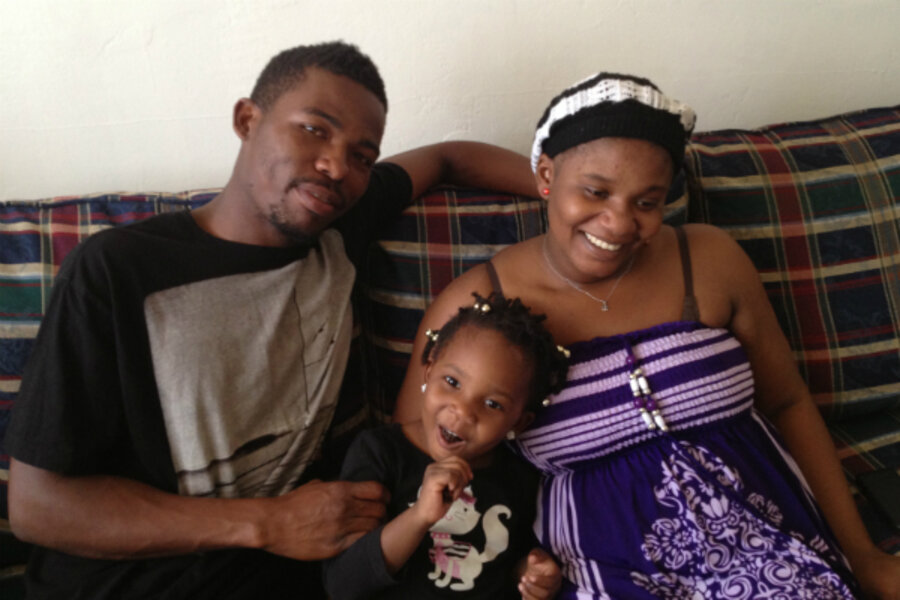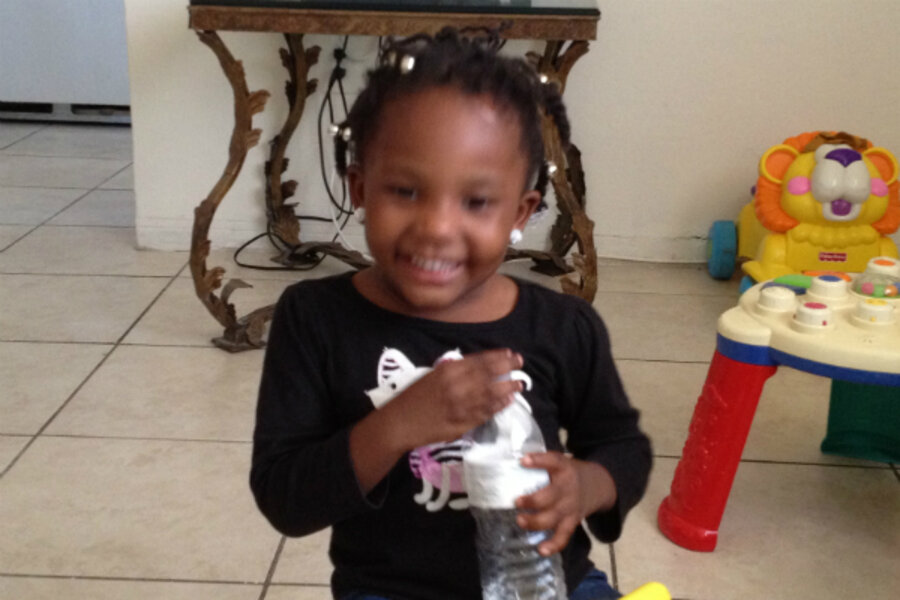Haiti earthquake baby: Saved from debris, she’s now a happy Miami toddler
Loading...
| Miami
Jenny looks and acts like your average three-year-old. She’s capricious, charming, and curious. She runs back and forth in her Miami apartment with carefree abandon. I have a hard time reconciling that this is the same, emaciated, maggot-infested infant I first met three years earlier when I drove by just as her uncle pulled her nearly lifeless body from a pile of rubble she’d been under for five days following Haiti’s deadly Jan. 12, 2010 earthquake.
The exchange happened in an instant – the three-month-old was handed to be to take to a makeshift hospital – but for the next hour, I was near hysteria, terrified that this infant would not survive long enough for us to get her to help. Driving was already a nightmare, given the dead bodies, smashed cars, and collapsed buildings clogging the roads. A colleague dripped water from a cloth onto Jenny’s lips, and we prayed as we lurched along.
Amidst all of the horror of those days following the quake, this was one of the few things that went right – we managed to make it to a makeshift hospital in time, and a competent staff attended to Jenny. Within hours they put her on an empty plane to Fort Lauderdale where she got the medical attention she needed. If any of these steps had been delayed, Jenny surely would have died.
Meanwhile, I had left the hospital to go back in search of her parents, who, when I found them, could hardly believe their daughter had survived. But it would be more than a month before Nadine Devilme and Junior Alexis would hold Jenny again. It took that long to convince the necessary authorities that they were her parents, and to secure the travel documents they needed to join her.
It’s only now, sitting in their sunny one-bedroom apartment in North Miami, that Nadine apologizes for not telling me that she had left behind a five-year-old son by another man she was with before Junior. She had kept her son’s existence secret from everyone – from immigration and from the organizations helping her leave – for fear of losing her chance to join Jenny.
Not a day goes by that she doesn’t think about him, she says. He’s living with his godmother in Port-au-Prince – his father died in the quake. Nadine doesn’t regret leaving Haiti behind, but she aches for her son, whom she’s seen only once since she left in 2010, and that was just for 10 days last summer. She would go more often if she could, she says with a bit of angst, but money is tight.
After Jenny’s medical treatment ended, Nadine and Junior were able to remain in the US through Temporary Protected Status afforded to Haitians following the quake. This allows them to work and travel, but they’ve had trouble making ends meet. Nadine was recently let go from her job as a chambermaid at a nearby hotel for medical reasons related to her pregnancy – she’s due this July. That leaves Junior to shoulder their bills; his salary from restaurant work barely covers their monthly expenses. The car they had was totaled earlier this year when a truck ran into it. Fortunately no one was seriously hurt.
Despite the daily pressures, they seem settled in a way I could not have predicted; older and wiser than their mid 20s. Nadine is a homebody and says she hasn’t really made any new friends. Junior, a keyboardist, has put together a band similar to the one he left behind and hopes someday to perform in local clubs.
Although their apartment – which costs them more than half of Junior’s salary – has touches of Haiti, a few knickknacks and the scent of Haitian spices, it’s also very American. Toys R Us-type games are scattered about. For a while Jenny went to a daycare facility, but when Nadine lost her job they couldn’t afford to keep sending her, so now she spends time with a Haitian woman who lives just a few doors down, where other kids also play. Jenny walks me down the hallway so I can meet her caretaker.
But mostly, during our visit, Jenny seems concerned about whether or not I’ll eat the glitter-wrapped piece of chocolate Nadine offered me, or if I’ll leave it for her when I go.
I tell her I’ll bring her chocolates of her own next time I visit, and she smiles, then gives me her hand and asks if she can walk me to my car.







